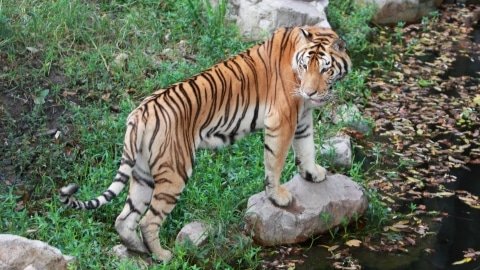Ex situ conservation is a conservation method where the plant or animal species is conserved outside of their natural habitat. This is a crucial conservation method for endangered species. In situ conservation, on the other hand, requires conservation efforts to be focused on protecting species in their natural ecosystem. Both methods are significant in improving the overall health of any ecosystem. Examples of ex situ conservation are zoos, gene banks, botanical gardens, and aquariums.
Advantages of ex situ conservation

Protection from predation and poaching
Animals in ex situ conservation live in very protected environments. The environment may have been artificially constructed to somewhat reflect the natural ecosystem. But it is free of threats like predators and poaching.
Monitoring the health of organisms is easy
Ex situ conservation efforts are mostly viable for small populations. This makes it easy for monitoring the health of the organisms. If any disease or sickness appears among the animal species, they can be quickly addressed. This is an advantage for animals living in ex situ conservation environment. In situ conservation efforts are mostly focused on protecting the animal and plant species from predation and poaching. Overall health of the species may be monitored, but individual health may go unmonitored.
Selective breeding
Breeding programs can improve the quality of an animal or plant species. Selective breeding reduces the risks of inbreeding, which may concern some in situ conservationists. This method of breeding allows human intervention in the reproduction process of an organism. Reproductive material may be acquired through gene banks and sperm banks. These may then be used to artificially inseminate an animal species.
Animals can be saved in the event of a natural disaster
Natural disasters can easily wipe out important organisms in affected regions. In situ conservation efforts may not be able to easily launch rescue operations. Ex situ conservation areas, on the other hand, are better prepared to handle natural disasters.
Endangered animals can be bred to increase their population
Endangered animals are those that exist in a very small population around the world. When organisms are threatened of extinction, it is ideal to keep them in protected spaces. So, ex situ conservation is ideal for such animals who are on the brink of extinction. For example, eggs from the last white rhino, Sudan who died in 2018 will be used to repopulate the species.
Research to understand an animal or plant species
Ex situ conservation systems are helpful in providing researchers the ability to closely study the animal species. This may be relatively difficult in other environments where the animals roam freely.
Examples of ex situ conservation environments
- Zoo – Zoos are one of the most popular forms of ex situ conservation. A lot of zoos focus on research and studies to better understand the animal species. Many of them also take part in selective breeding programs. Since zoos are a rich resource for humans to understand wildlife, research in zoos support conservation efforts.
- Aquarium – Just like land animals are protected in zoos, aquariums help in protecting marine organisms. The efforts in maintaining aquariums and ensuring that they resonate with the actual environment for the species is difficult.
- Animal shelters – Animal shelters are mostly designed to take in animals that have been abandoned. These are still a place for in situ conservation since these animals are usually not in their natural habitat. Donkeys, horses, and several breeds of dogs and cats may not be adapted to the environment they live in. This is because they have been displaced from their natural habitat.
Animal club drives awareness among children about conservation efforts. Children learn about in situ and ex situ conservations in theory. Through our animal handling workshop and animal school visits, we are able to provide them with first-hand experiences. Our animal workshop includes fun sessions which educate children about conservation and the natural habitat of the animals. Even animal parties are a great place to increase awareness about conservation efforts. You can throw an animal party to help children have fun and at the same time educate them about animal conservation.



